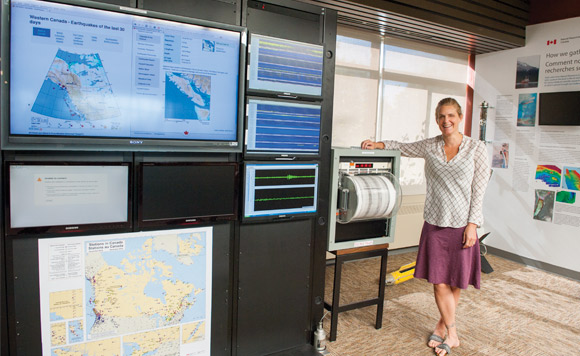by Paula Kully –
Many people living on the Saanich Peninsula may not be aware that our region is home to one of the largest marine research centres in Canada. I’m speaking of the Institute of Ocean Sciences (IOS) located on Pat Bay. This well-hidden gem in our community holds many remarkable secrets and is a treasure trove of interesting scientific research. The IOS officially opened on February 28, 1979. Today, over 250 scientists, researchers and support staff work in the building, making it one of the largest employers on the Peninsula.
This summer, the public had the opportunity for a behind-the-scenes look at what happens at the IOS. An open house was held to celebrate Canada 150 and the 175th anniversary of the Geological Survey of Canada, which is Canada’s oldest scientific agency and one of the first government organizations, founded in 1842. The open house was a huge success, attracting approximately 5,000 people, and included tours and talks by scientists on everything from earthquakes to shipwrecks, tsunamis, climate change and more.
The Institute of Ocean Sciences is operated by Fisheries and Oceans Canada. It is a major research centre that explores the coastal waters of the northeast Pacific Ocean, the western Canadian Arctic, and fresh water tributaries across British Columbia to the Alberta border. Research encompasses two divisions: Canadian hydrographic service which produces nautical charts; and ocean science which includes research such as the effects of global warming on marine ecosystems, contaminants in arctic ice or even predicting the time and location of a tsunami.
IOS also houses the Canadian Coast Guard and Marine Traffic Coordination Centre. The Coast Guard provides search and rescue, responds to marine pollution and operates the research vessels used by IOS scientists, while the Marine Traffic Coordination Centre provides the initial response to ships in distress, reduces the probability of marine collisions, and is a cornerstone in marine information collection and dissemination.
Staff of the Canadian Wildlife Service and North Pacific Marine Science Organization or PICES are also located in the building. PICES, established in 1992, promotes and coordinates research in the North Pacific and adjacent seas. Members of PICES include Canada, the United States, Japan, China, Korea and Russia.
The Pacific Geoscience Centre of Natural Resources also operates out of IOS. Its focus is the research of earthquakes and one of its scientists is Camille Brillon (pictured above). Camille is a seismologist who began her work at the Institute in 2009 as a graduate student. For the past four years, she has been working on a major geohazard project on the north coast near Kitimat. The project has involved collecting data on the potential for landslides, submarine slides and earthquakes in an area that has not yet been widely researched.
The project established instruments to detect earthquakes and monitor if there are small quakes. As well, GPS were established along the coast to monitor long term motion at the site.
Camille explains that: “GPS are an interesting thing that people don’t realize are used a lot. When a GPS is set up and then analyzed four years later, we can see how the earth has moved.”
We are all aware of “the big one,” the earthquake that is inevitable. Camille has assured me that the West Coast is “not going to break off and fall into the ocean,” but there certainly will be major impacts and the work of scientists like Camille can help to prepare us.
Camille’s staff also collects information for seismic hazard maps which are used for building codes and they analyze large earthquakes to learn from them.
One such earthquake happened on October 27, 2012 off the coast of Haida Gwaii. The earthquake registered as a 7.8, produced an 11-metre tsunami and was felt all the way to Edmonton, but because if its location, there were no casualties or impact on humans.
This is only a small sampling of the fascinating work that goes on right here on the Saanich Peninsula at the Institute of Ocean Sciences. Anyone curious to learn more is welcome to stop by, get a visitors’ pass and explore the building for themselves.




